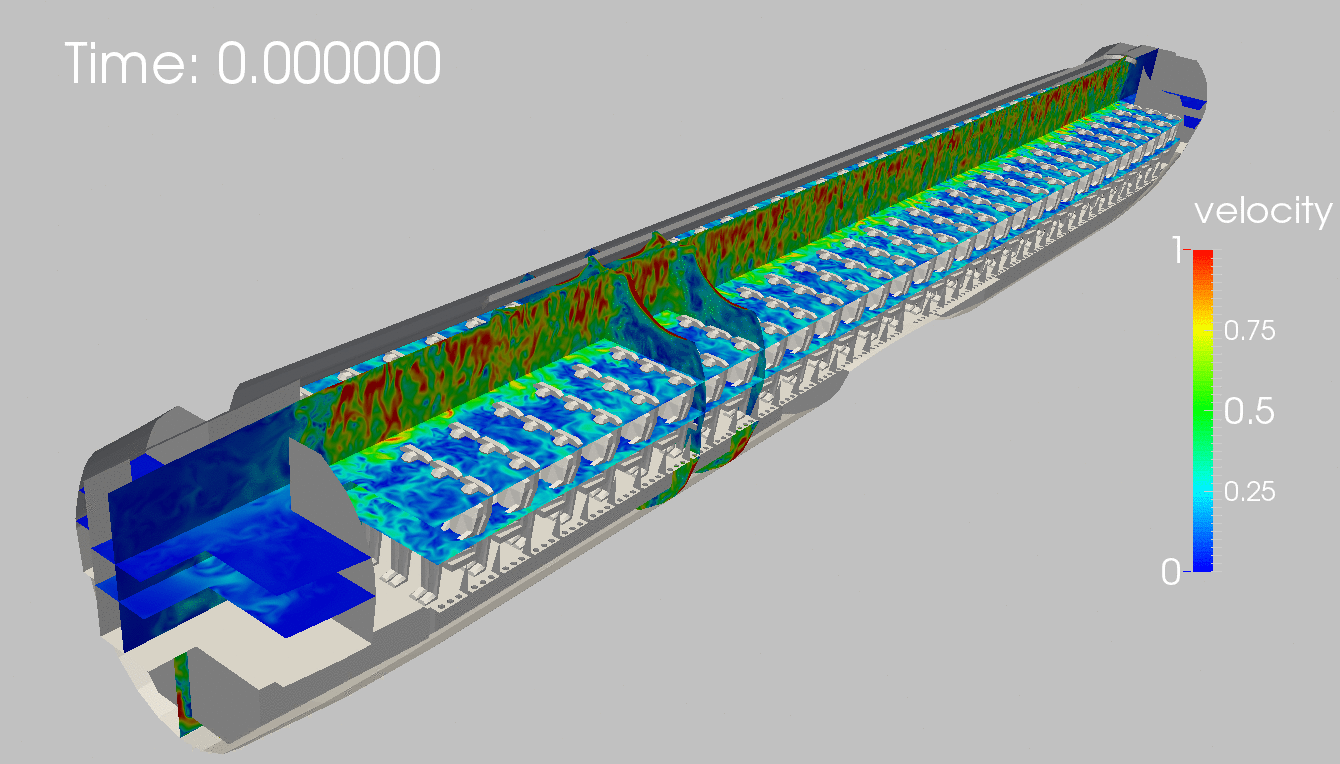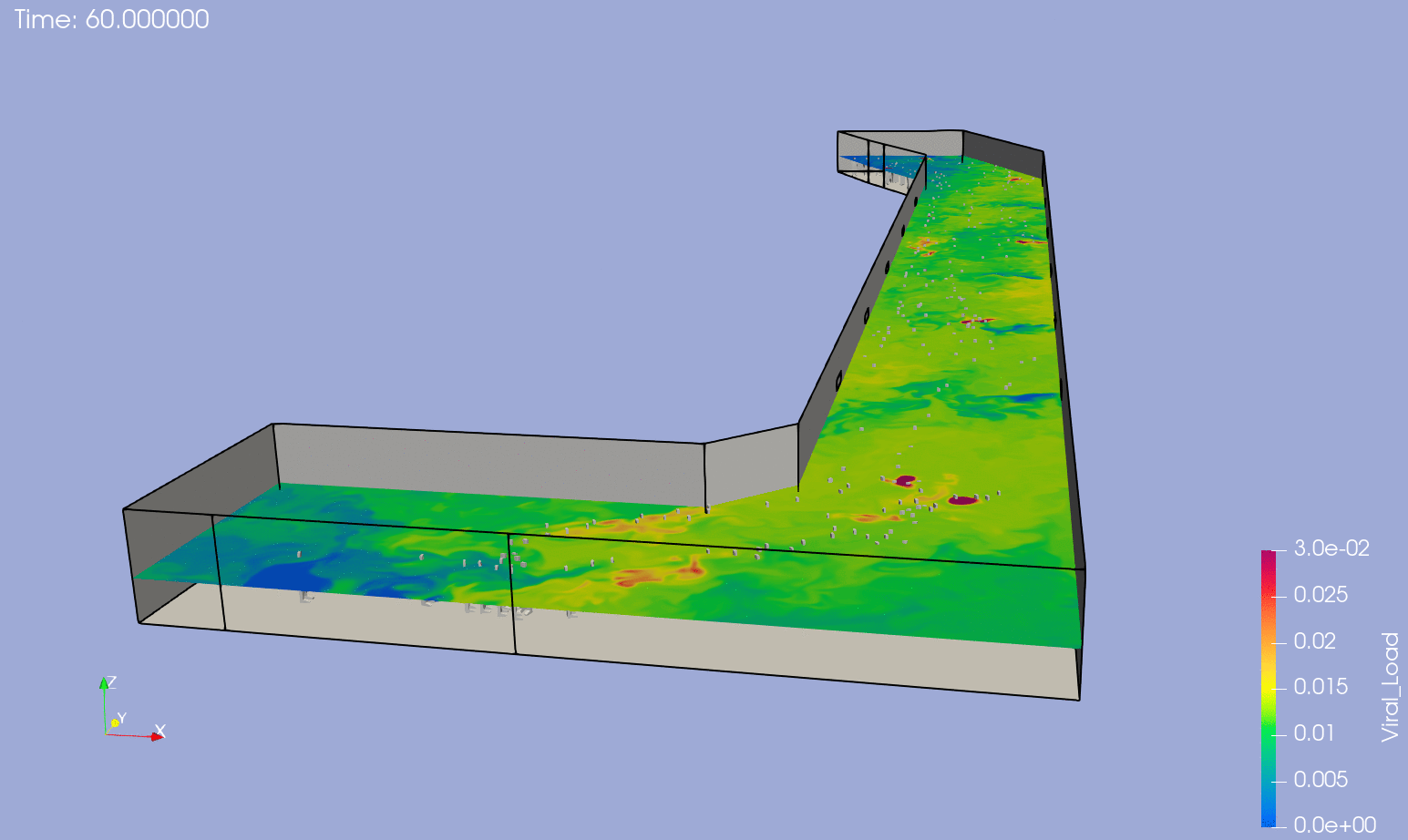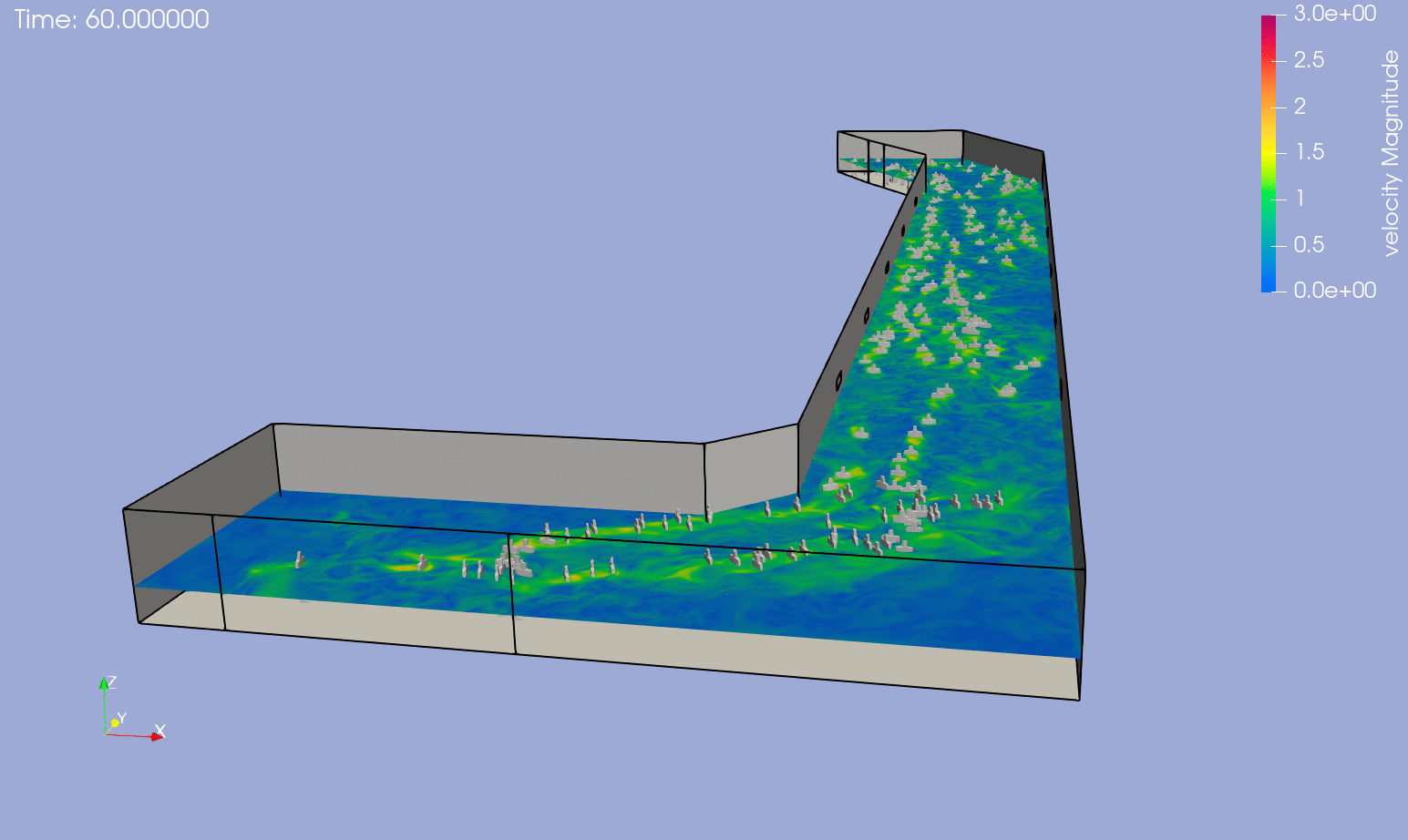Research Project Categories
For Further Reading on this subject:
- R. Löhner, H. Antil, S. Idelsohn and E. Onate – Detailed Simulation of Viral Propagation in the Built Environment; arXiv:2006.13792 [physics.soc-ph] (2020); see also: https://link.springer.com/article/10.1007/s00466-020-01881-7
- M. Gröndahl, Ch. Goldbaum and J. White – What Happens to Viral Particles on the Subway; New York Times, August 10 (2020); see also: https://www.nytimes.com/interactive/2020/08/10/nyregion/nyc-subway-coronavirus.html
- A. Mandavilli – A Smoking Gun: Infectious Coronavirus Retrieved From Hospital Air; New York Times, August 11 (2020); see also: https://www.nytimes.com/2020/08/11/health/coronavirus-aerosols-indoors.html
- R. Löhner and H. Antil – High Fidelity Modeling of Aerosol Pathogen Propagation in Built Environments With Moving Pedestrians; arXiv:2009.03365 [physics.soc-ph] (2020).
- A series of simulations shown on the NBC Universal Today Show, September 30 (2020), see: https://www.today.com/health/ventilation-covid-19-reduce-spread-proper-airflow-t192366
- NSF Newsletter highlight, see: https://www.nsf.gov/mps/dms/documents/2020-11-Item4-Antil.pdf
- A note on measures taken by Federal Courts to reopen for in-person jury trials: https://www.uscourts.gov/news/2021/03/04/smoke-tests-protect-courtroom-air-covid-19
- M. Gröndahl, T. Mzezewa and O. Fleisher – How Safe Are You From Covid When You Fly ?; New York Times, April 18 (2021); see also: https://www.nytimes.com/interactive/2021/04/17/travel/flying-plane-covid-19-safety.html
- B. Weiser – Jury Duty Is Back, and It Looks Very Different; New York Times, April 22 (2021); see also: https://www.nytimes.com/2021/04/22/nyregion/new-york-courts-pandemic-jury-duty.html
- A series of smoke simulations shown on the NBC Universal Today Show, April 30 (2021), see:
- R. Löhner and H. Antil – High Fidelity Modeling of Aerosol Pathogen Propagation in Built Environments With Moving Pedestrians; arXiv:2009.03365 [physics.soc-ph] (2020). Int. J. Num. Meth. Biomed. Engng. (2021);e3428. https://doi.org/10.1002/cnm.3428
- R. Löhner and Harbir Antil – High-Fidelity Simulation of Pathogen Propagation, Transmission, and Mitigation; SIAM News , 54, 6, July/August (2021). https://sinews.siam.org/Details-Page/high-fidelity-simulation-of-pathogen-propagation-transmission-and-mitigation
- R. Löhner, H. Antil, A. Srinivasan, S. Idelsohn and E. Onate – High-Fidelity Simulation of Pathogen Propagation, Transmission and Mitigation in the Built Environment; Archives of Computational Methods in Engineering (2021). https://doi.org/10.1007/s11831-021-09606-6
- R. Löhner – High-Fidelity Simulation of Pathogen Propagation, Transmission and Mitigation in the Built Environment; Seminar given at CIMNE, UPC, Barcelona July 8 (2021). https://www.youtube.com/watch?v=l4j0BJC49VA
- R. Löhner, H. Antil, J.M. Gimenez, S. Idelsohn and E. Onate – A Deterministic Pathogen Transmission Model Based on High-Fidelity Physics; (2022). https://doi.org/10.48550/arXiv.2202.08718
Sneezing in Transportation Security Agency (TSA) Queues:
One of the obvious vectors for viral contamination and spread are security and passport examination queues in airports. Air flow is moderate, passengers are in very close proximity, and in some airports queues wind back and forth in narrow lanes. These simulations show a sneezing person in a TSA queuing scenarios. The distribution of particles and the absolute value of the velocity in the center plane over time can be discerned.
One can see that the large (red) particles follow a ballistic path and have some influence on the flow. This `ballistic phase’ ends at about 1 second. The smaller (green) particles are quickly stopped by the air, and then sink slowly towards the floor in close proximity to the individual sneezing. The even smaller (cyan, blue) particles rise with the cloud of warmer air exhaled by the sneezing individual, and disperse much further at later times.


Sneezing in a Generic Hospital Room:
This case considers a typical hospital room. Of interest here was the dispersion of particles in the first minute after coughing/sneezing, in particular the reach into neighboring halls and the amount of `negative pressure’ needed to keep all contaminants in the room. The video below shows the distribution of particles over time. Note how far the smaller particles spread over time, illustrating in a very dramatic way the serious risk health providers face in such situations.

Sneezing in a Generic University Laboratory Teaching Classroom:
This case considers a typical university laboratory teaching classroom. Of interest here was the dispersion of particles in the first minute after coughing/sneezing, in particular the reach to other students in the room. Heating, ventilation and Air Conditioning (HVAC) systems have been designed so as to mix air very efficiently. This can be seen below for the complex flowfield that is generated by the 9 entry vents and 2 exit vents located in the ceiling of the room.



Sneezing in the middle or the left of the room results in different clouds of particles. Note that as before the large (red) particles follow a ballistic path land close to the person sneezing (`2m rule’). This `ballistic phase’ ends at about 1 second. The smaller (green) particles are quickly stopped by the air, and then sink slowly towards the floor in close proximity to the individual sneezing. The even smaller (cyan, blue) particles follow the air stream, and disperse much further at later times. Note how far the smaller particles spread over time, illustrating in a very dramatic way the serious risk students could face in such situations.


Sneezing in a Generic Subway Car:
This case considers a typical subway wagon. Of interest here was the dispersion of particles when coughing/sneezing, in particular the extent of possible infection via aerosol particles. HVAC systems have been designed so as to mix air very efficiently. This can be seen below for the very complex flowfield that is generated by the 4 entry slits and 2 exit vents located in the ceiling of the wagon.



Sneezing in the middle of the wagon quickly leads to a wide spread of the smaller particles. Note that as before the large (red) particles follow a ballistic path land close to the person sneezing (`2m rule’). This `ballistic phase’ ends at about 1 second. The smaller (green) particles are quickly stopped by the air, and then sink slowly towards the floor in close proximity to the individual sneezing. The even smaller (cyan, blue) particles follow the air stream, and disperse quickly, covering half of the wagon in less than a minute. This case illustrates in a very dramatic way the imperative use of masks in such crowded environments.


These simulation were featured in an article in the New York Times on August 10, 2020, see: https://www.nytimes.com/interactive/2020/08/10/nyregion/nyc-subway-coronavirus.html
Sneezing in an Airplane Cabin:
The flow in airplane cabins has been extensively discussed in the media throughout the Covid-19 pandemic. Given that the air in planes is renewed much more often than air-conditioned buildings (one exchange every 2 minutes vs. one exchange every 12-15 minutes) one would assume airplanes to be much safer. Indeed, influenza studies have shown that the `radius of transmission’ is limited to 2-3 rows, with large droplet to surface to hand and then nose/eyes/mouth being the most common route of infection. Nevertheless, there could be regions of stagnant flow that would be conducive to pathogen transmission. This prompted the analysis of cabin flow and sneezing in a B-737.
As before, the interest centered on the dispersion of particles when coughing/sneezing, in particular the extent of possible infection via aerosol particles. HVAC systems have been designed so as to mix air very efficiently. Unlike older models, the flow in this cabin enters through two parallel slits in the ceiling close to the windows, moves towards the center, and then exits through the holes in the floor close below the windows.
The geometry was given from a detailed STL triangulation. The mesh had approximately 890 Mels. The run was carried out to several minutes of physical time, requiring approximately 24 hours on close to 8,000 cores. As expected, the flowfield is highly turbulent.

One can see that at the level of passenger heads the flow is a comfortable 20-30 cm/sec, not too strong, but giving the feeling of an air-conditioned environment. Different `sneezing positions’ were considered, and only the smaller particles were considered. The movement and extent of these `sneezing clouds’ is colored with a unique color. One can see that the clouds remain bounded to 2-3 rows/seats in every direction. This is qualitatively in line with studies of influenza and Covid-19 transmission in airplanes Note that the age of air at the level of the head of the passengers is less than 50 seconds. The higher times seen at both ends of the cabin are an artifice of boundary conditions: the outflow conditions in these zones were unknown, and therefore no outflow was considered.


These simulation were featured in an article in the New York Times on April 18, 2021, see:
https://www.nytimes.com/interactive/2021/04/17/travel/flying-plane-covid-19-safety.html
Sneezing in a Classroom:
This case considers a classroom. Of interest here was the dispersion of particles when coughing/sneezing, in particular the influence of proper ventilation and/or the opening of doors and windows to improve airflow. Even under normal HVAC conditions sneezing in the middle of the classroom quickly leads to a wide spread of the smaller particles. Note that as before the large (red) particles follow a ballistic path land close to the person sneezing (`2m rule’). This `ballistic phase’ ends at about 1 second. The smaller (green) particles are quickly stopped by the air, and then sink slowly towards the floor in close proximity to the individual sneezing. The even smaller (cyan, blue) particles follow the air stream, and disperse quickly, covering half of the wagon in less than a minute. Wearing a mask drastically reduces the amount of particle exhaled into the surrounding air, and hence the probability of infection.


With the HVAC running at low speed the spread takes longer, but eventually reaches large parts of the room. As before, wearing a mask, drastically reduces the amount of particle exhaled into the surrounding air, and hence the probability of infection, an effect seen even after 5 minutes.




Opening doors and windows leads to a faster renewal of the air in the room, but given the complexity of the flow-field (notice the large vortical structures in corners), even in this case some particles remain. Wearing a mask drastically reduces the amount of particle exhaled into the surrounding air, and hence the probability of infection. This case illustrates in a very dramatic way the benefits of better air circulation and improved ventilations, as well as the imperative use of masks in such crowded environments.




Some of these simulations were summarized and presented in the NBC Today Show on September 30, 2020, see: https://www.today.com/health/ventilation-covid-19-reduce-spread-proper-airflow-t192366
Sneezing in a Narrow Corridor With Moving Pedestrians:
This case considers a generic, narrow corridor with moving pedestrians. This may be typical of train or subway stations, as well as underground passages in cities with colder climates. Of interest here was the dispersion of particles when coughing/sneezing, in particular the extent of possible infection via aerosol particles. A typical HVAC systems was considered. HVAC systems are designed to deliver comfortable air speeds, i.e. speeds below 0.3m/sec. People move at 1.1-1.3m/sec, implying that they will produce wakes and `stir the air’. This can be seen below. Note the very complex flowfield that is generated by the moving pedestrians.


Sneezing anywhere leads to a wide spread of the smaller particles. Note that as before the large (red) particles follow a ballistic path land close to the person sneezing (`2m rule’). This `ballistic phase’ ends at about 1 second. The smaller (green) particles are quickly stopped by the air, and then sink slowly towards the floor in close proximity to the individual sneezing. The even smaller (cyan, blue) particles follow the air stream, and disperse quickly, covering most of the volume in less than 20 seconds. This case illustrates in a very dramatic way the imperative use of masks in such crowded environments. A similar conclusion can be drawn by considering a transport equation for the viral load in the volume, and following its distribution at chest height over time.


Pedestrians in a Long Passage:
This case considers a typical rush hour scenario in a long passage. Situations like this happen daily in train stations or airports. The central part of the passage is 82m long, 10m wide and 4m high. Three open windows are located along the passage, allowing for fresh air to enter (in this case from the right), the effect of which is visible in the low levels of viral matter in their neighbourhood.
A steady stream of pedestrians enters through both extremes and then moves towards the exit on the other side. At any given time approximately 250 pedestrians are in the simulation domain. 70% of the pedestrians entering are assigned as healthy, 10% as infected but asymptomatic (i.e. not infecting) and 20% as infected and infecting.
For the infecting pedestrians, the average time between sneezing is set to 30 sec with a variation of plus/minus 5 sec and a sneeze duration of 1 sec. The total mesh size was in excess of 120 million elements. The two minutes of simulated time took approximately 8 hours using 1,024 cores.
The velocity and viral matter concentration at mid-headheight are displayed below .


The simulation below clearly shows the need for better ventilation: after a while, almost all pedestrians are wading through a `soup of viral matter’.

